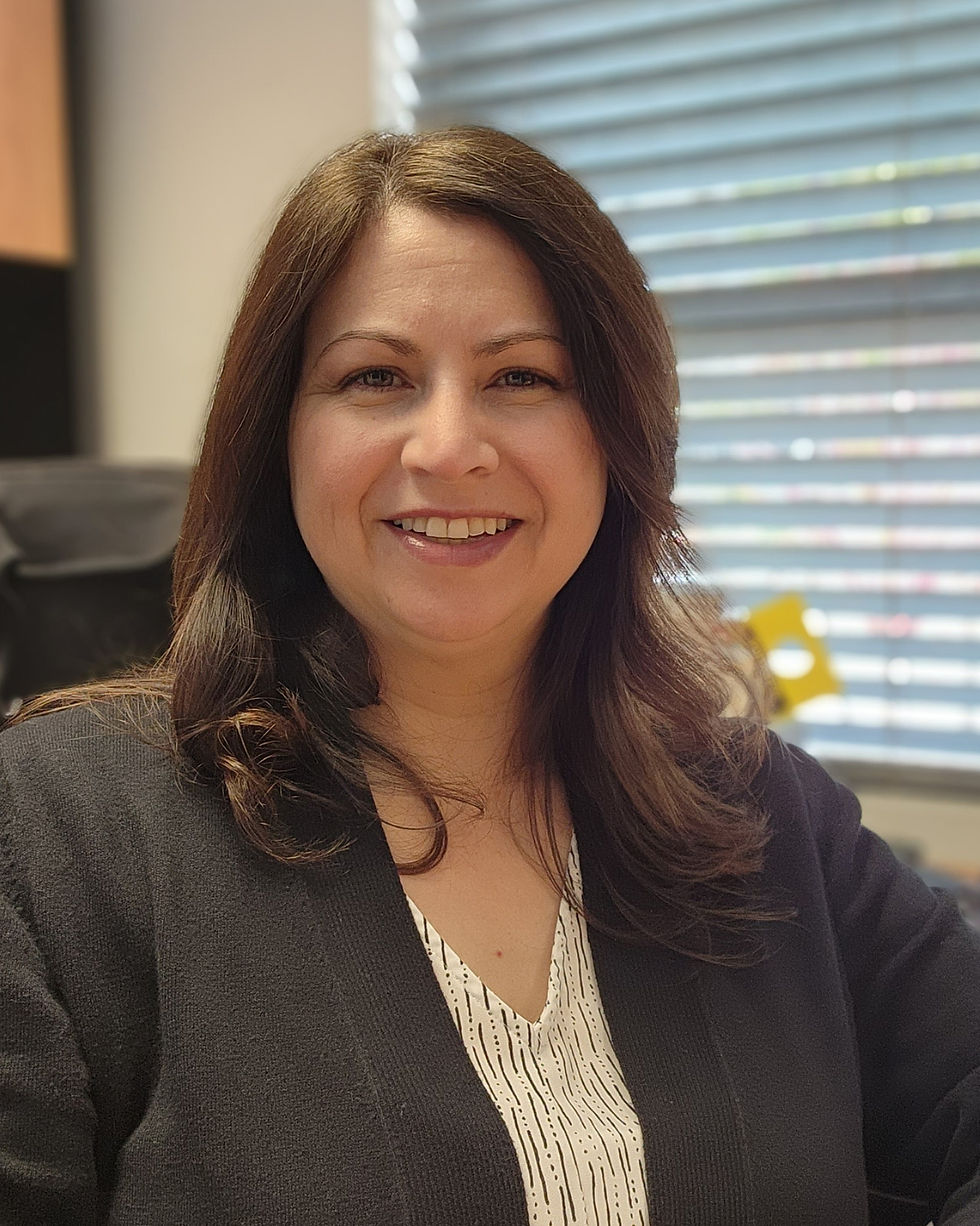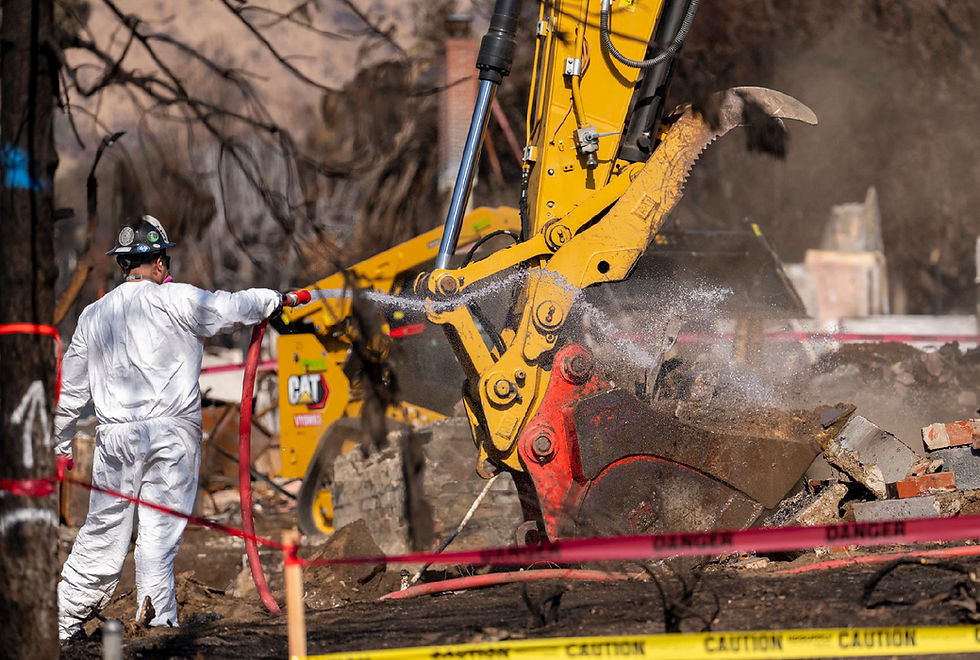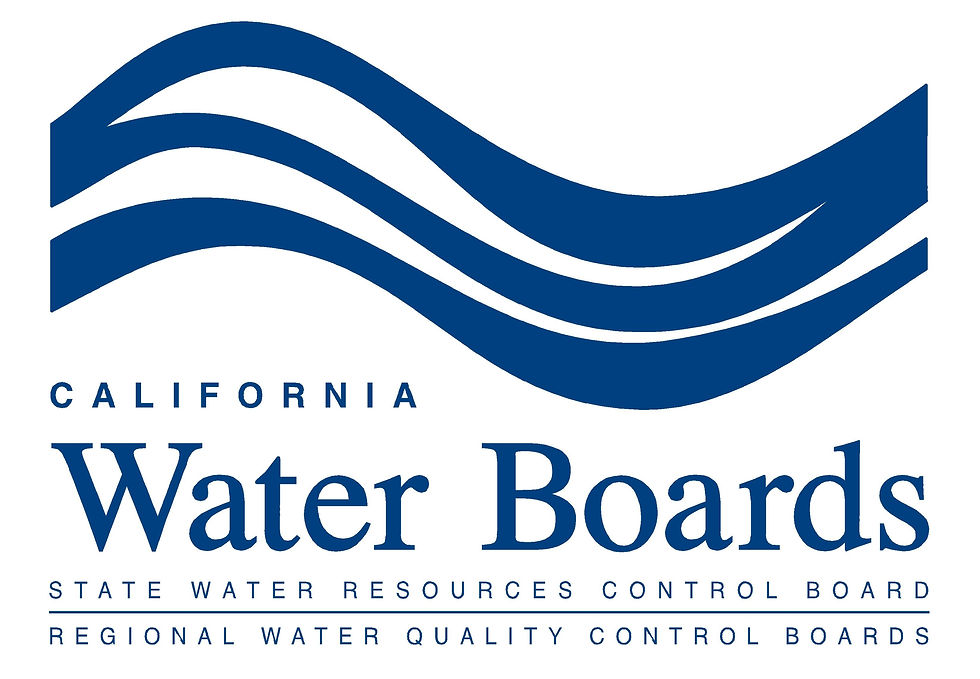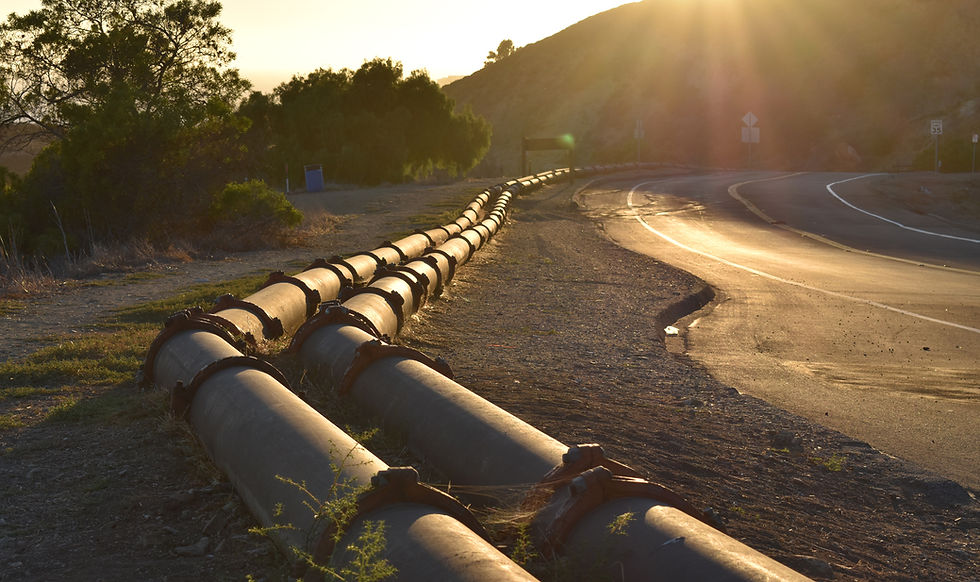Fighting Fire with Resilience
- Brooks McKinney, APR

- Jul 31
- 9 min read
Updated: Aug 7
Jennifer Torres guides Lincoln Avenue Water Company’s efforts to renovate and restore water delivery infrastructure after the devastating Eaton Fire in Los Angeles.

Early on the evening of Jan. 7, 2025, a brush fire ignited in Eaton Canyon near the eastern edge of Altadena, an unincorporated community in the foothills of the San Gabriel Mountains 14 miles northeast of downtown Los Angeles. Fierce Santa Ana winds—wind gusts of 70-to-80 mph were measured in the fire zone—carried sparks and embers rapidly west and southwest through Altadena, igniting new fires far ahead of the central fire front.
Against this backdrop, Jennifer Betancourt Torres, general manager of Altadena-based Lincoln Avenue Water Company (LAWC), received a call from one of her employees that the Eaton Fire had reached and crossed the eastern boundary of the LAWC service area.
“When I got the call, several of our operators were already on their way to our (main) facility in western Altadena to check on our water delivery equipment,” said Torres. “Despite dangerous conditions—homes across the street from our office were on fire—our employees wanted to take whatever steps they could to minimize damage to our facility. I credit their efforts with our ability to rebound quickly from this devastating wildfire event.”
In the end, the Eaton Fire would claim 18 lives and more than 9,400 structures, including the homes of three LAWC board members and two LAWC employees.

Rising from the Ashes
Today, Torres oversees all aspects of LAWC’s operations, including fire-related recovery, repair and upgrades of its water delivery infrastructure.
LAWC is a mutual water service company owned and operated by its shareholders/customers. Before the Eaton Fire, the company had approximately 16,000 customers and 4,500 residential and commercial service connections (including local fire hydrants) in a 2.5 square mile service area in northwestern Altadena. Fire damage to homes served by LAWC resulted in the loss of 2,600 service connections, or about 58% of the company’s service base.
Protected by Proactivity
LAWC’s infrastructure, however, fared much better.

“We operate 10 facilities in Altadena, each one located adjacent to a reservoir,” explains Torres. “Of the eight facilities located within the burn area, only one building and one reservoir suffered any significant fire damage.”
She attributes this remarkable statistic to LAWC’s proactive investments in resilience.
“Over the years, we’ve focused on replacing combustible building materials at our facilities with more fire-resistant materials, and creating defensible space around each building,” she says. “The fact that we came through fairly unscathed is a testament to the success of our planning efforts, particularly since the fire destroyed almost all of the homes surrounding our facilities.”
Finding Her Rhythm
Torres grew up in the 1980s in the historic and culturally rich neighborhood of Highland Park, about six miles northeast of downtown LA. Her dad was a musician, her mom a kindergarten aide at the local elementary school.
Torres flirted with becoming a saxophone player herself—she played in junior high and high school and even joined a jazz band—but ultimately decided that one musician in the family was enough.
“I’ve always been self-driven,” she observes, “a quality I learned from watching my dad hustle in the gig-driven and highly competitive music industry. He showed me the value of creating stability in my life, both financially and professionally.”

After high school, Torres secured her first job in the retail banking industry, joining California Bank and Trust as a customer service representative.
After two years, she moved over to Citizens Business Bank, where Lincoln Avenue Water Company became one of her clients. After two years with Citizens, however, she spotted a customer service position at the water company that offered better pay, more flexible hours, and better benefits.
“As a kid, I was always ‘the coordinator’ (read bossy) among my siblings,” she recalls. “I figured the customer service representative job would be a great use of that skill. And it launched my passion for the water service industry.”
Torres joined LAWC in September 2003 … and has never looked back.
Digging In, Earning Respect
Determined to make the most of her new opportunity, Torres began taking local university classes in various aspects of the water industry, eventually earning her State of California certification for water treatment and distribution. In 2005, she was promoted to Water Quality Coordinator, becoming LAWC’s liaison to all federal and California state water agencies. In this role, she ensured the company’s compliance with all applicable water quality requirements.

“Anything that you can think of related to water quality, that was my job,” she says proudly.
Eventually, she rose through the ranks of the 12-employee water company to become the chief assistant to Robert Hayward, LAWC’s general manager, all while continuing to grow her expertise in business management, accounting, human resources, and of course, water management and distribution services. Following Hayward’s retirement in 2018, LAWC’s Board of Directors appointed her general manager.
Serving Western Altadena
Today, LAWC gets its water from three primary sources: groundwater wells, treated water it purchases from the Metropolitan Water District of Southern California (MWD)—typically a mixture of water from the Colorado River and California’s State Water Project—and seasonal surface water from nearby Millard Canyon.

The company operates a gravity-fed water distribution network that uses multiple pumping stations and storage reservoirs at various altitudes within its service area to maintain consistent water pressure and supply to its customers.
Restoring Service
By Jan. 27, reports Torres, LAWC had restored its potable water system to 100 percent, a significant achievement given the disruption to 2600 of its service lines. Fortunately, none of its underground water mains were damaged by the fire.

“The destruction of 2600 structures connected to our water mains led to an uncontrolled release of water, which created a significant loss of water pressure in our main water delivery lines,” she explains. “The drop in water pressure created a vacuum that had the potential to pull airborne contaminants back into our main LAWC service lines.”
To restore water pressure in the main delivery lines, she adds, the company had to turn off the water at the meter shut-off valve at each service location, or, if the valve was inoperable, cap the service line to prevent any further disruptions to the main water delivery lines.
“We’d been using imported water at the time of the fire, so that water was considered potable,” says Torres. “Still, we had to flush the lines—our network includes copper, plastic and galvanized pipes—to ensure that no contaminants had sneaked into the system during or after the fire.”
Sampling Reality
Part of the challenge LAWC and other local water companies faced during their recovery period was complying with a nascent state law that specifies water quality requirements following a wildfire.

“There was a framework in place, but no real template on how best to move forward and address these issues,” Torres emphasizes. “We worked very closely with the State Water Resources Control Board to create new processes for flushing and sampling our water.”
To date, she notes, LAWC has spent almost $75,000 conducting water quality sampling—she calls the process ‘tedious’—but knows the testing will help reassure current and returning customers that they can always trust the company’s water quality.
Keeping Up with Carelessness
LAWC has largely restored its water system to normal, but the company is still dealing with recurring damage to its water delivery infrastructure caused by other agencies and contractors engaged in removing fire debris and repairing broken utility lines.

”After the fire, we were getting thousands of DigAlert® tickets from multiple agencies, and it was quite difficult to manage,” explains Torres.
“If you put out a DigAlert® and don’t get a response from other agencies—recipients of said alerts are expected to come mark the location of their lines to prevent diggers from hitting their lines—you’re required to hand dig so that you don’t hit other (agencies’) lines.
”Unfortunately, a lot of contractors (eager to clear debris) just go ahead and start digging with heavy equipment. That’s when we experience damage to our valves, water meters and service lines.”
Adding Resilience
On the upside, notes Torres, the Eaton Fire presents an opportunity for the community and the company to modernize local infrastructure, making it more resilient and responsive to the needs of emergency responders in the future.

“The California State Water Resources Control Board have recently strengthened their regulations regarding the installation and annual testing of backflow prevention devices for newly constructed homes,” she says. “Had those devices [which prevent water from flowing back into the potable public water supply from customer sites] been in place before the fire, they could have kept contaminants from entering our water system, which may have shortened our recovery process.”
For its part, she continues, LAWC plans to upgrade its ability to start back-up generators connected to each of its facilities. The company currently has to send someone to every site to manually turn on the generators.
“We’re looking at new ways to monitor and turn on those generators remotely so that if a fire or some other unsafe condition exists, we can still manage our operation,” she says.

Making It All Work
Workdays begin early in the three-bedroom house that Torres shares with her husband and their two school-aged children in Whittier, Calif. about 18 miles east of LA. After getting the kids up, fed, and out the door to school—Torres shares these responsibilities with her husband—she tackles the 30-mile commute to Altadena.
“I’m a solo commuter,” she confesses. “With no traffic, I can be in my office in 30 minutes, but normally my commute time is about 50 minutes. Fortunately, I have my podcasts—her favorites are The Weekly Show with John Stewart and Crime Junkie—to keep me company.”
Leading with Humility
In the office by 8:00 a.m., Torres starts and ends most days catching up on e-mail. Her schedule is hectic—many more coordination meetings with customers and regulatory agencies now than before the fire—but considerably calmer than the weeks following the Eaton Fire, when she worked 15-hour days for 18 days straight.

And what makes it all work? Collaboration, Torres declares.
“I know that I’m the final decision maker and I take seriously the information my staff gives me, but I don’t need to come up with all of the best ideas,” she insists. “My goal as a manager is to surround myself with people who are smarter than I. That makes us a better company.”
Serving the Water Community
In addition to leading LAWC, Torres remains active in the broader water service industry, which has witnessed increased collaboration and coordinated recovery actions among water providers since the Eaton Fire.

“I served for two years as the area representative on the Raymond Basin Management Board,” she offers, “a position that rotates among four local water companies.” The board manages groundwater resources within the Raymond Basin to ensure the sustainable and equitable use of local water resources among its users.
Torres is also quite active with the California Association of Mutual Water Companies, an organization that Lincoln Avenue helped found in 2013 to represent and advocate for the interests of mutual water companies.
Believing in Tomorrow
Looking ahead, Torres is optimistic about the restoration of LAWC’s customer base, a small but important indicator of Altadena’s ability to recover, psychologically and financially, from the devastation of the Eaton Fire.
“We’re seeing more and more property owners whose homes were destroyed ask to have their water service restored to help save trees and other landscaping while they’re rebuilding,” she says.
But Torres knows that the Eaton Fire will not be Altadena’s last wildfire.

Signs of Altadena's gratitude for LA County firefighters and first responders, and its commitment to rebuild are present throughout the community. Brooks McKinney photo.
“The key to this community’s future is resilience,” she observes. “Lincoln Avenue’s investments in infrastructure allowed us to bounce back and support the community’s water needs relatively quickly. We’re confident that our shareholders and community partners will continue to support one another as they work to rebuild their lives and restore the structural, environmental, and cultural identity that has always been Altadena.”
# # #
If you enjoyed this profile, I’d like to recommend that you check out my profile of Marc Mattox who is guiding the restoration of infrastructure in Paradise, Calif. following devastating wildfires there in 2018. To suggest other topics or people for me to feature on the blog, please send your ideas to brooks@personsofinfrastructure.com. Many thanks.







Comments